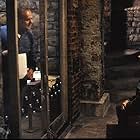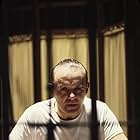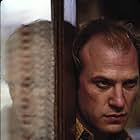A young F.B.I. cadet must receive the help of an incarcerated and manipulative cannibal killer to help catch another serial killer, a madman who skins his victims.A young F.B.I. cadet must receive the help of an incarcerated and manipulative cannibal killer to help catch another serial killer, a madman who skins his victims.A young F.B.I. cadet must receive the help of an incarcerated and manipulative cannibal killer to help catch another serial killer, a madman who skins his victims.
- Won 5 Oscars
- 71 wins & 50 nominations total
- Director
- Writers
- All cast & crew
- Production, box office & more at IMDbPro
Best Picture Winners by Year
Best Picture Winners by Year
See the complete list of Best Picture winners. For fun, use the "sort order" function to rank by IMDb rating and other criteria.
Storyline
Did you know
- Trivia(at around 17 mins) Jodie Foster claims that during the first meeting between Dr. Hannibal Lecter and Clarice Starling, Sir Anthony Hopkins's mocking of her southern accent was improvised on the spot. Foster's horrified reaction was genuine since she felt personally attacked. She later thanked Hopkins for generating such an honest reaction.
- Goofs(at around 44 mins) As Forensics comes to take photos of the victim's body, the "corpse" visibly blinks as hands touch its face.
- Quotes
Hannibal Lecter: A census taker once tried to test me. I ate his liver with some fava beans and a nice chianti.
- Crazy creditsThere is a 'Moth Wrangler/Make-Up' listed in the crew list.
- Alternate versionsThe Finnish-dubbed VHS version removes:
- Hannibal Lecter beating Pembry against the cell's bars, and spraying liquid to his eyes (along with the shots of the cuffed guard screaming "Jesus Christ!", and a shot of him trying to break loose).
- Lecter beating a guard with a nightstick several times (reduced from 6 hits to 1!).
- A outdrawn sequence that comes right after Lecter has whacked the guards (where he plays music and walks across the dead guard's body) is completely removed (along with Lecter's dialogue Ready when you are, sergeant Pembry).
- Right after Buffalo Bill is shot by Clarice Starling there is a long-lasting (about 15 secs) shot of his bloody dead body, that in the cut version is not that long anymore.
- ConnectionsEdited into A-Z of Horror (1997)
- SoundtracksAmerican Girl
Performed by Tom Petty & The Heartbreakers (as Tom Petty and the Heartbreakers)
Written by Tom Petty (as T. Petty)
Courtesy of Gone Gator Records
Featured review
A thrilling must see
I just saw, for the second or third time, this cinematographic masterpiece, during an « UGC culte » evening, in Paris. The list of the Big Five Academy Award winners is short. There are currently three of them, in nine decades: It Happened One Night (1934), One Flew Over the Cuckoo's Nest (1975) and ... The Silence of the Lambs (1991). This is not really surprising, this film being excellent, endowed with a script skillfully elaborated by Thomas Harris, with an irreproachable casting including Anthony Hopkins, Jodie Foster and Scott Glenn. In addition, the director Jonathan Demme delivers a work obviously enjoying an admirable preparatory work.
Without unduly spoiling the script, if you have not seen it yet, by the greatest fluke: a psychopath known as the Buffalo Bill sows terror in the Middle West by kidnapping and murdering young pulpy women, after partially or completely skinning them. Clarice Starling, a young FBI agent, is in charge of interviewing Hannibal Lecter, a well-known former psychiatrist who has also the characteristic of a truly intelligent psychopath focused on cannibalism. Hannibal Lecter is able to provide Clarice Starling with providential information about Buffalo Bill . But he agrees to help her only in exchange for information about the young woman's private life. Between them is established a link of fascination and repulsion.
As a synthesis: a thrilling must see. 9/10 of 10
Without unduly spoiling the script, if you have not seen it yet, by the greatest fluke: a psychopath known as the Buffalo Bill sows terror in the Middle West by kidnapping and murdering young pulpy women, after partially or completely skinning them. Clarice Starling, a young FBI agent, is in charge of interviewing Hannibal Lecter, a well-known former psychiatrist who has also the characteristic of a truly intelligent psychopath focused on cannibalism. Hannibal Lecter is able to provide Clarice Starling with providential information about Buffalo Bill . But he agrees to help her only in exchange for information about the young woman's private life. Between them is established a link of fascination and repulsion.
As a synthesis: a thrilling must see. 9/10 of 10
helpful•4315
- FrenchEddieFelson
- Aug 10, 2019
Details
- Release date
- Country of origin
- Official site
- Languages
- Also known as
- Silence of the Lambs
- Filming locations
- Production companies
- See more company credits at IMDbPro
Box office
- Budget
- $19,000,000 (estimated)
- Gross US & Canada
- $130,742,922
- Opening weekend US & Canada
- $13,766,814
- Feb 18, 1991
- Gross worldwide
- $272,742,922
- Runtime1 hour 58 minutes
- Color
- Sound mix
- Aspect ratio
- 1.85 : 1
Contribute to this page
Suggest an edit or add missing content





















































